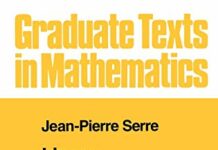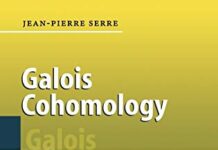
Ebook Info
- Published: 1980
- Number of pages: 249 pages
- Format: PDF
- File Size: 5.78 MB
- Authors: Jean-Pierre Serre
Description
The goal of this book is to present local class field theory from the cohomo logical point of view, following the method inaugurated by Hochschild and developed by Artin-Tate. This theory is about extensions-primarily abelian-of “local” (i.e., complete for a discrete valuation) fields with finite residue field. For example, such fields are obtained by completing an algebraic number field; that is one of the aspects of “localisation”. The chapters are grouped in “parts”. There are three preliminary parts: the first two on the general theory of local fields, the third on group coho mology. Local class field theory, strictly speaking, does not appear until the fourth part. Here is a more precise outline of the contents of these four parts: The first contains basic definitions and results on discrete valuation rings, Dedekind domains (which are their “globalisation”) and the completion process. The prerequisite for this part is a knowledge of elementary notions of algebra and topology, which may be found for instance in Bourbaki. The second part is concerned with ramification phenomena (different, discriminant, ramification groups, Artin representation). Just as in the first part, no assumptions are made here about the residue fields. It is in this setting that the “norm” map is studied; I have expressed the results in terms of “additive polynomials” and of “multiplicative polynomials”, since using the language of algebraic geometry would have led me too far astray.
User’s Reviews
Reviews from Amazon users which were colected at the time this book was published on the website:
⭐The mathematical content and exposition are at a high level typical of Serre.I have not finished reading the entire book, but here are some misprints I have found that may serve as a useful warning. NB: most of these errors are Not in the 3rd French edition…Chapter 1:section 4, pg. 14, 2nd centered display: the ramification indices should be e_{beta} not e_{p} in the product.section 5, pg. 15, first formula needs to be N: I_{B}-> I_{A}, Not the other way around.section 6, pg. 17, last sentence of first paragraph, replace the inclusion symbol $in$ with the word “in”. Clearly, f is an element of A[X] and not an element of k[X]. In the French ed. Serre correctly used “dans” and did not us the symbol $in$.section 7, pg. 22, in proof of Prop. 21, 2nd paragraph, 3rd sentence, replace “contain” with “contains”.4th sentence: should be, “… we must have bar{L}_{S} = bar{K}_{T}” not bar{L}. [separable consequence is later, namely in the Corollary(!)]Chapter 2:sec 1, pg. 28: third sentence should be “one sees that E is the union of (A:xA) cosets of modules xE,…”. As is in the book, the sentence does not make grammatical sense.sec 2, pg. 29: the def. of w must carry a v’ not just v, that is: w = (1/m) v’ is a discrete valuation of L.sec 3, theorem 1, (i): change K to hat{K}; so the completion of L_i has degree n_i over the completion of K.sec 3, exercise 1: the suggested reference should say Section 3 of Bourbaki Algebra, not 7. (going by Hermann Paris 1958 as usual)Chapter 4:sec 1, pg. 63, prop 3, need K’ (not K) in def. of e’, that is: e’ = e_{L/K’}.in the proof of prop 3, the s and t for “st, t in H” need to be italicized.sec 2, prop 6, first line of proof: gothic beta should be gothic p, that is to each x in p^{i}_{L}sec 3, lemma 3, last line of proof: upper case Phi is nowhere defined, need lower case phi, that is: phi'(u)….so theta and phi must coincide.sec 3, statement of lemma 5, again phi, not Phi.Some tips for the beginner:- Know how localization behaves as a functor via, say Atiyah-Macdonald.- For a clean and clear proof that separable <=> nondegenerate Tr(,) see Roman’s “Field Theory” (Bourbaki uses etale algebras to get this result, a bit more than needed).- P. Samuel’s “Algebraic theory of numbers” (Dover publ. now!) has a very elegant exposition of the proof of quadratic reciprocity that is alluded to at the end of section 8.
⭐This rating is not based on the mathematical content in this book – I would recommend Serre’s influential and classic account to any willing reader. My low rating is due solely to the quality of the text. I was slightly shocked to receive a textbook more than twice the size (see photo) of most books (indeed, all that I have seen) published by Springer. I am at a loss as to why they printed it in such a way, and am quite frustrated that I will need to carry around this oversized version of a real masterpiece in the mathematics literature.
⭐日本国内印刷のpaperbackの場合は、70頁にPDFのアイコンのようなマークが印刷されてしまって、本文と重なって読めなくなっています。オンデマンド出版のデータの不具合かと思われます。返品して交換しましたが、交換した商品にも、もちろん、同じミスプリントがありました。
⭐
⭐2018年の4月18日にAmazonでこの本(ペーパーバック)を購入しましたが、他の方のレビューにあるような不具合はどこにも見当たりませんでした。非常に良い本です。
⭐
Keywords
Free Download Local Fields (Graduate Texts in Mathematics, 67) in PDF format
Local Fields (Graduate Texts in Mathematics, 67) PDF Free Download
Download Local Fields (Graduate Texts in Mathematics, 67) 1980 PDF Free
Local Fields (Graduate Texts in Mathematics, 67) 1980 PDF Free Download
Download Local Fields (Graduate Texts in Mathematics, 67) PDF
Free Download Ebook Local Fields (Graduate Texts in Mathematics, 67)




